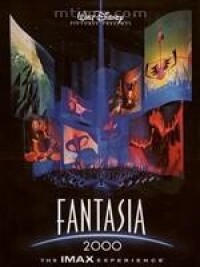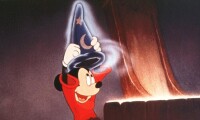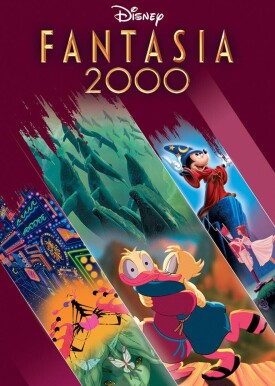幻想曲2000
幻想曲2000

幻想曲2000
雖然《幻想曲》一映當年反應好壞參半,但時至六十年後的今日,《幻想曲》已成為迪士尼動畫庫中最有歷史和紀念價值的資產。而且為慶祝千禧年的來臨,迪士尼便決定將"沃爾特叔叔”親生的《幻想曲》修輯,再重新配樂,替這個親生子洗乾淨衣裳,漂漂亮亮的迎接新世紀,同時亦加插新片段,證明與時代並進。不過,洗衣服的主意原來不及新衣好,《幻想曲》原本配合七段樂章的動畫變成只剩一段,改頭換面的《幻想曲2000》仍源用沃爾特叔叔將動畫與古典音樂結合的思想,但破天荒以IMAX膠片制式製作,即以比傳統35厘米大十倍的膠片製作,亦表現了動畫科技進步。

《幻想曲2000》截圖
迪士尼在全球影響力甚巨,米奇老鼠成為有如可樂或麥當勞般家傳戶曉的商標,要慶祝《幻想曲》六十大壽,全球多個國家義不容辭,聯合在千禧年元旦於各地IMAX劇場公映《幻想曲2000》。
1.貝多芬:第五號交響曲(Symphony No.5)(命運)
《幻想曲2000》首先登場的是貝多芬的“第五號交響曲”,本段落只是一個開場,純粹用一些幾何圖形的聲影變化,畫面十分超現實,跟當初1940年的《幻想曲》第一段巴赫的“D小調觸技曲與賦格曲”有異曲同工之妙。
2.雷斯庇基:羅馬之松(Pines of Rome)
《 幻想曲2000》第二段則是雷斯庇基的“羅馬之松”,此段的主角則是一群鯨魚,這群鯨魚在大海中遨遊,整體呈現出的畫面十分優美,最後鯨魚們甚至飛上青天,完全擺脫現實世界的束縛!
3.格什溫:藍色狂想曲(Rhapsody in Blue)
“藍色狂想曲”則完全不同於其它段落的純粹古典音樂,本段落用到的是有點爵士味道的近代樂風,背景則是在20世紀30年代的紐約大都會,本段落大膽的用色及線條呈現出大都會生活的光怪陸離,尤其那位曼哈頓樂師穿著冰刀的狂舞節奏,實在令人印象深刻。
4.肖斯塔科維奇:第二號鋼琴協奏曲——快版(Piano Concerto No. 2,Allegro,Opus 102)
肖斯塔科維奇的“第二號鋼琴協奏曲”是安徒生著名的童話《堅毅的錫兵》,講述獨腿的玩具錫兵和玩意芭蕾舞蹈家的愛情故事,結果稍有改動,迪斯尼的風格自然是邪不勝正、有情人終成眷屬,本段落的人物迪斯尼則是採用電腦動畫製作,再配合傳統手繪的背景。
5.聖桑:動物狂歡節(Carnival of the Animals)
“動物狂歡節”則是描述一群動作一致的紅鶴,卻因為其中一隻紅鶴迷上了玩溜溜球,使得整群紅鶴步調大亂,這隻紅鶴玩起溜溜球的姿勢十分滑稽,弄得水花四濺,同伴也跟著遭殃。
6. 杜卡:《魔法師的學徒》(The Sorcerer's Apprentice)
“魔法師的學徒”則是《幻想曲1940》保留的段落,本片由迪斯尼招牌明星米奇主演,片中米奇偷懶亂施法術,睡著后甚至夢到自己指揮海浪、星辰,沒想到驚醒后才發現淹沒大水,結果搞的一團糟。
7.艾爾加:威風凜凜進行曲(Pomp & Circumstance)
“威風凜凜進行曲”則是聖經里“諾亞方舟”的故事,這回迪斯尼讓唐老鴨來扮演諾亞,當暴風雨來臨前夕趕著一大堆動物登上方舟,後來更與洶湧的大洪水搏鬥,最後風平浪靜,所有動物都登上方舟甲板,共同迎向光明的未來。
8.斯特拉文斯基:火鳥組曲(Firebird Suite)
《幻想曲2000》最後一個段落則是斯特拉文斯基的“火鳥組曲”,片中無論是自然萬物的生生不息,或是火鳥翻飛燃燒整片天空,呈現的光影變化帶給觀眾視覺上的震撼,為《幻想曲2000》畫下絢爛的休止符。
(1)電影中音樂為電影而服務,而幻想曲1940、幻想曲2000則反之。
“幻想曲2000”由八段不同曲目的音樂配上動畫師根據音樂想像出的故事合成。本片是迪士尼電影公司重新整理編撰1940年的“幻想曲”故事而成,其中包括一段舊“幻想曲”中的米老鼠做魔法學徒的段落,而其他七個段落全是2000年嶄新的創作。
看這部電影就像在聽交響樂,完全藝術化的動畫電影,一開場就是貝多芬第五交響曲,中間的也全是《動物狂歡節》等名曲,和當年沃爾特。迪斯尼親自製作的《幻想曲》一脈相承。從舊作中留下的米奇魔法學徒,和音樂的結合堪稱完美。其中直線條表現紐約生活的一段,安徒生的《堅毅的錫兵》一段,我都非常喜歡。唐老鴨演繹諾亞方舟的一段,我差點看哭了。
(2)classic向來被束之高閣,曲高和寡。你需要反覆得聆聽才能體會出曲子表達的情感,而進入和作者共鳴的境界則需要更多的靜心與人生閱歷。相比之下,快餐文化的pop更容易讓人沉浸其中。p.s.classic與pop各有千秋,並無優劣,只是music大樹的兩個枝杈罷了。
那麼怎麼樣才能進入classic的世界?Fantasia 2000為我們展示了一條途徑。通過將聲與影有機地結合起來,通過刺激聽覺與視覺,步入古典殿堂。正如一首歌可能很平常,但是作為電影中的背景樂,配合以當時的情節與畫面,會令我們的內心得到一種新的體驗與震撼(p.s.獨自等待的插歌就都很棒)。幻想曲2000里,暴風雨中的蝴蝶,藍色狂想曲,唐老鴨版諾亞方舟,天鵝,玩具小兵的故事,魔法師的學徒等,無一不在我腦中深深地刻下了印痕。每當聽到這些曲子時,畫面就會在腦中流轉。可以說很多人喜歡古典樂,就是從看這部影片開始。
| 角色 | 演員 | 備註 |
| 史蒂夫·馬丁 | Himself - Introductory Host | |
| - | Mickey Mouse | 配音 韋恩·艾爾溫 |
| - | Donald Duck | 配音 托尼·安塞羅 |
| Leopold Stokowski | Himself - Conductor | |
| Ralph Grierson | Pianist (segment "Rhapsody in Blue") | |
| - | Featured Soprano | 配音 Kathleen Battle |
| Itzhak Perlman | Himself - Host | |
| 昆西·瓊斯 | Himself - Host | |
| 貝特·米德勒 | Herself - Hostess | |
| 詹姆斯·厄爾·瓊斯 | Himself - Host | |
| 佩恩·吉列特 | Himself (as Penn) | |
| 安吉拉·蘭斯伯瑞 | Herself - Hostess | |
| James Levine | Himself - Host | |
| - | Daisy Duck | 配音 露西·泰勒 |
| Teller | Himself - Host | |
| 埃里克·古德伯格 | Animator | |
| Deems Taylor | Himself - Host | |
| Benee Leavy | Violinist | |
| Deborah Vukovitz | Violinist | |
| Paul Brizzi | Animator (uncredited) | |
| Hendel Butoy | Animator (uncredited) | |
| Yefim Bronfman | Pianist |
| 導演 | 詹姆斯·阿爾格James Algar、Paul Brizzi、Hendel Butoy、弗朗西斯·吉勒巴斯Francis Glebas、埃里克·古德伯格Eric Goldberg |
| 編劇 | 埃里克·古德伯格Eric Goldberg、安徒生、喬·格蘭特Joe Grant、Perce Pearce、Carl Fallberg、Paul Brizzi |
| 製作人 | Lisa C. Cook、羅伊·愛德華·迪士尼Roy Edward Disney、Donald W. Ernst、Patricia Hicks、David Lovegren |
| 攝影 | Tim Suhrstedt |
| 剪輯 | Jessica Ambinder-Rojas、Lois Freeman-Fox、Julia Gray、Craig Paulsen、Gregory F. Plotts |
| 選角導演 | Mary Hidalgo、Ruth Lambert |
| 藝術指導 | Maurice Hunt |
| 美術設計 | Tom Codrick、Dan Cooper、Susan Goldberg、Dean Gordon、Michael Humphries、Maurice Hunt |
| 視覺特效 | Dave Bossert、Richard E. Hollander、Mauro Maressa |
| 副導演(助理) | Paul F. Bernard、Steve Fernandez、Gregg Goldstone、Terry Ham、Bill Hoyt |
Fantasia 2000 is the thirty-eighth animated feature in the Disney animated features canon. The film was produced by Walt Disney Feature Animation and was released by Walt Disney Pictures and Buena Vista Distribution. It premiered in the United States on December 17, 1999, was released to IMAX theatres on January 1, 2000, and was later released to standard theatres nationwide on June 16, 2000. The film uses a similar format to Walt Disney's 1940 film Fantasia, visualizing classical music compositions with various forms of animation and live-action introductions. The music is performed by the Chicago Symphony Orchestra, arranged and conducted by James Levine, excepting two pieces arranged by Peter Schickele and the Sorcerer's Apprentice segment from the original film.
The composers and their works, in the order they are used in the film, are:
Ludwig van Beethoven's Symphony No. 5 in c minor-I. Allegro con brio – abstract patterns resembling butterflies and bats explore a world of light and darkness which are conquered by light at last.
Ottorino Respighi's Pines of Rome – this segment features a pod of frolicking humpback whales in an unusual 'aerial' setting, and within icebergs. The final section, the Via Appia gives the impression of the larger pod of adults in migration.
George Gershwin's Rhapsody in Blue – an episode of 1930s-era New York City, depicting the day in the lives of several people within the Depression-era bustling metropolis, as scenes drawn in the style of Al Hirschfeld's famous cartoons of the era, including an animation of Gershwin the composer, himself at the piano. The little girl in the hotel is based on the Eloise character created by Kay Thompson.
Dmitri Shostakovich's Piano Concerto No. 2 in F Major-I. Allegro – a retelling of Hans Christian Andersen's The Steadfast Tin Soldier. The setting is appropriate - the concerto was written as a gift by Shostakovich to his musically gifted young son, and the percussive rythms also suit a story about a soldier. However, the ending is a happy one in contrast with that of the original story.
Camille Saint-Saëns's The Carnival of the Animals, Finale – A flock of ballerina flamingos (itself a nod to the Hippopotami, Ostriches and Elephants of Dance of the Hours from Fantasia), with a rebellious slapstick Flamingo with a yo-yo, designed to delight children with the on-screen hysterics; music arranged by Peter Schickele
Paul Dukas's The Sorcerer's Apprentice – a segment from the original Fantasia featuring Mickey Mouse, conducted by Leopold Stokowski.
Edward Elgar's Pomp and Circumstance - Marches 1, 2, 3 and 4 – a retelling of the story of Noah's Ark, with Donald Duck as first mate to Noah. Donald musters the animals to the Ark, and misses, loses, and is reunited with Daisy Duck in the process; music arranged by Peter Schickele, including a wordless soprano solo as part of the No. 1 march ('Land of Hope and Glory').
Igor Stravinsky's Firebird Suite - 1919 Version – the story of a spring sprite and her companion Elk. After a long winter she restores the life to the forest but accidentally awakes the Firebird spirit of a nearby volcano. Angered the Firebird proceeds in destroying the forest and seemingly the sprite. She is restored to life however after the destruction and the forest life is reborn with her. The story is considered an exercise in the theme of Life-death-rebirth deities.
